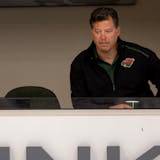For motorists who are unable or unwilling to power off their phones while behind the wheel, a man from Sartell, Minn., has a new invention that might curb the temptation to text and drive.
It's called CellSlip. The product made its public debut last month when it was distributed to law enforcement and traffic safety officials attending a conference in Duluth. It's a bright red nylon sleeve lined with a conductive fabric that blocks radio frequencies from reaching cellphones placed inside.
The idea behind CellSlip is to eliminate the distractions drivers face when a phone rings or pings, said creator Mitch Bain.
"A lot of people are not getting in their car proactively wanting to use their cellphone, but when they get that message alert or Snapchat or Facebook message, that dopamine goes off and there is the urge to respond right away," Bain said. So he thought, "What if we can take out human error and just totally be disconnected?"
The easy solution is simply to turn the devices off, but Americans just can't seem to do that. More than 81 percent of cellphone users say their phone is always on, according to pewinternet.org. The average cellphone user checks it 35 times a day by some estimates, including while on the road.
Recent research from AAA found that 70 percent of motorists report talking on a cellphone while driving. More than 42 percent admit to reading a text message or e-mail while driving and nearly a third admit to typing or sending an e-mail or text.
Bain had long known that nearly a quarter of all traffic crashes resulting in injury or death are attributed to distracted drivers. Those staggering numbers became real last summer when his wife, Savanna, and three kids in the car were rear-ended at a traffic signal in St. Cloud by a driver who was on the phone. They were not seriously hurt, but that's when Bain, a software engineer and entrepreneur hobbyist, said, "It was go time. That accident could have been prevented."
Bain isn't ready to bring CellSlip to the ABC-TV show "Shark Tank" just yet, but he does have the backing of AAA, the Minnesota Safety Council and the Traffic Safety Foundation.


